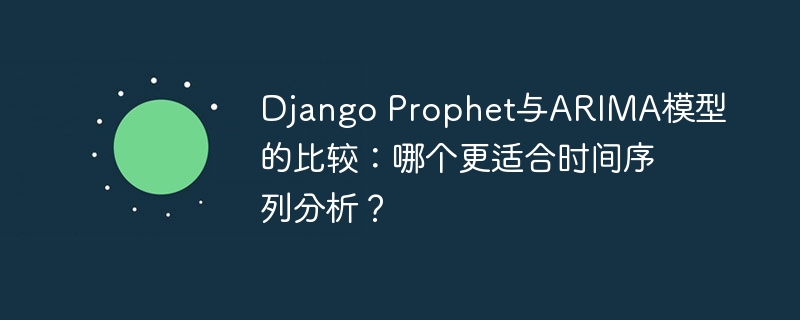
Comparison of Django Prophet and ARIMA models: Which one is more suitable for time series analysis?
Introduction:
Time series analysis is an important statistical analysis method used to reveal the patterns and trends of time series data. In recent years, with the development of machine learning and artificial intelligence technology, many advanced time series models have emerged. Among the more mainstream ones are the Django Prophet model and the ARIMA model. This article will compare the advantages and disadvantages of these two models and give code examples in practical applications to help readers choose the model that better suits their needs.
1. Model introduction:
- Django Prophet model:
The Django Prophet model is a time series prediction framework open sourced by Facebook. It is based on the GPC model of cross-sectional data modeling, and can effectively handle multi-variable, multi-period and holiday time series data through flexible non-linear trend models and holiday effect processing.
- ARIMA model:
ARIMA (Autoregressive Integrated Moving Average) model is a classic time series model. It adopts the idea of regression analysis to establish a regression model for the time series process, and converts the non-stationary sequence into a stationary sequence through operations such as differences, and then models it through the ARMA model.
2. Comparison of advantages and disadvantages:
- Advantages of Django Prophet model:
(1) Relatively simple and easy to use: Django Prophet model provides rich interfaces and Encapsulated, users can only focus on input data and prediction results without having to understand the principles of complex algorithms in depth.
(2) Processing complex time series: The Django Prophet model can automatically handle complex situations such as multi-variables, multi-periods and holiday effects, and has a wider scope of application.
(3) Flexible nonlinear trend model: The Django Prophet model can flexibly adapt to nonlinear time series trends, and works better for certain data sets with strong nonlinear relationships.
- Advantages of the ARIMA model:
(1) Stability and interpretability: The estimation of ARIMA model parameters is based on the statistical properties of the time series and has strong stability and interpretability. The parameters of the model The meaning is clear.
(2) Better stationarity processing: The ARIMA model can convert non-stationary sequences into stationary sequences through difference operations, and is suitable for some situations that require stationarity assumptions.
(3) Wide range of application fields: After long-term theoretical and practical accumulation, the ARIMA model has been widely used in time series analysis in economics, finance, meteorology and other fields.
- Disadvantages of the Django Prophet model:
(1) Large computational overhead: The Django Prophet model uses a complex Bayesian method for parameter estimation, which has a large computational overhead and may be required for large-scale time series data. Longer computation time.
(2) The effect of short-term prediction is average: Compared with the ARIMA model, the Django Prophet model is better at long-term prediction, but may be slightly inferior at short-term prediction.
- Disadvantages of the ARIMA model:
(1) It is difficult to process complex time series: The ARIMA model is relatively difficult to process complex time series data, such as multi-variables, multi-periods and holiday effects. .
(2) High requirements for data: The ARIMA model requires data to have a certain degree of stability and stationarity, and non-stationary sequences need to be properly processed, which increases the complexity of practical applications.
3. Example analysis:
The following is a specific example analysis to compare the effects of Django Prophet and ARIMA models in time series data prediction.
Suppose we have a set of sales data, including two variables: date and sales. We first use the Django Prophet model to predict:
from prophet import Prophet
import pandas as pd
# 读取数据
df = pd.read_csv('sales_data.csv')
# 将数据格式转化为Django Prophet需要的格式
df['ds'] = pd.to_datetime(df['date'])
df['y'] = df['sales']
# 构建Django Prophet模型
model = Prophet()
model.fit(df)
# 构建未来时间序列
future = model.make_future_dataframe(periods=365)
# 进行预测
forecast = model.predict(future)
# 输出预测结果
print(forecast[['ds', 'yhat', 'yhat_lower', 'yhat_upper']].tail())Copy after login
Next, we predict the same sales data through the ARIMA model:
from statsmodels.tsa.arima_model import ARIMA
import pandas as pd
# 读取数据
df = pd.read_csv('sales_data.csv')
# 将数据格式转化为ARIMA需要的格式
sales = df['sales']
# 构建ARIMA模型
model = ARIMA(sales, order=(1, 1, 1))
model_fit = model.fit(disp=0)
# 进行预测
forecast = model_fit.forecast(steps=365)
# 输出预测结果
print(forecast[0])Copy after login
By comparing the prediction results of the two models, as well as the calculation time and Due to the complexity of the model, we can conclude that for long-term forecasting and complex time series analysis, using the Django Prophet model may work better; while for short-term forecasting and time series with higher requirements for stationarity, the ARIMA model may be more suitable.
Conclusion:
Django Prophet and ARIMA models are two common time series analysis models. It is important to choose the right model based on your specific needs. This article compares their advantages and disadvantages and gives code examples in practical applications. I hope readers can choose a time series model that suits them based on the actual situation.
Reference:
- Taylor, Sean J., and Benjamin Letham. "Forecasting at scale." The American Statistician 72.1 (2018): 37-45.
- Box, George EP, et al. Time series analysis: forecasting and control. John Wiley & Sons, 2015.
The above is the detailed content of Comparison of Django Prophet and ARIMA models: Which one is better for time series analysis?. For more information, please follow other related articles on the PHP Chinese website!






